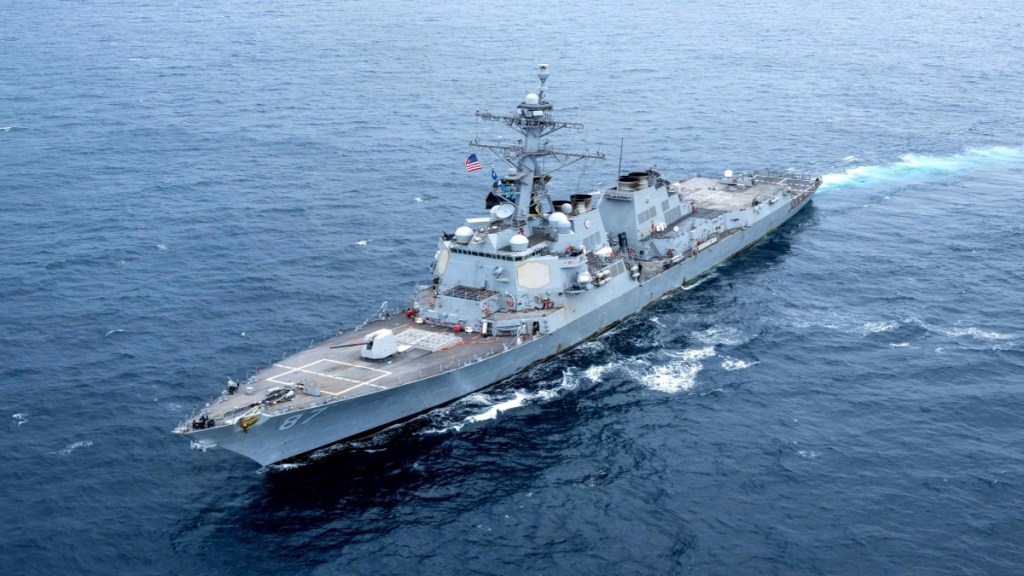In a recent escalation, Yemen’s Houthi rebels targeted two US Navy destroyers, the USS Stockdale and the USS Spruance, as they navigated the Bab el-Mandeb Strait on Monday. According to Pentagon press secretary Maj. Gen. Pat Ryder, the Iranian-backed Houthis launched at least eight drones, five anti-ship ballistic missiles, and three anti-ship cruise missiles at the American vessels. Fortunately, the attacks were neutralized, causing no injuries or damage. Maj. Gen. Ryder confirmed that “the incoming fires were successfully engaged.”
Strategic Significance of the Bab el-Mandeb Strait
The Bab el-Mandeb Strait, a critical waterway between the Red Sea and the Gulf of Aden, handles roughly $1 trillion in annual global trade. Over recent months, Houthi rebels have ramped up attacks on vessels passing through the strait, attributing these strikes to the ongoing Israel-Hamas conflict and related military tensions.
In response, the US and allied forces have initiated airstrikes on Houthi launch and storage sites, establishing an international coalition to protect commercial vessels. Despite these measures, the Houthi attacks have continued, and shipping through the strait has dropped significantly due to heightened risk.
Houthi Allegations and Commercial Ship Incidents
Houthi military spokesman Brig. Gen. Yahya Saree claimed in a pre-recorded statement that the rebels had targeted two American destroyers in the Red Sea with ballistic missiles and drones. Additionally, reports emerged of a separate commercial ship attack in the southern Red Sea, approximately 80 miles southwest of Hodeida. The United Kingdom Maritime Trade Operations (UKMTO) confirmed the attack, adding that no injuries were reported and the vessel proceeded on its journey. It remains unclear whether this incident was linked to the assault on the US Navy ships, though similar attacks have occurred in the area.
Widespread Attacks on Commercial Vessels Since Gaza Conflict
Since October 2023, the Houthis have launched attacks on over 90 merchant ships using drones and missiles, in some cases seizing or sinking vessels. Their stated goal is to target ships they believe are associated with Israel, the US, or the UK as a protest against Israel’s military campaign in Gaza. However, the Houthis have also targeted vessels with no direct links to the conflict, including Iranian-bound ships. Many missiles and drones have been intercepted or failed to reach their targets, and the attacks have caused a notable increase in shipping delays and cancellations in the region.
Houthi Maritime Threats and Alleged “Safe Passage” Payments
In addition to physical attacks, a UN panel of experts recently reported that the Houthis may be demanding fees from shipping agencies to guarantee safe passage through the Bab el-Mandeb Strait. Sources suggest the Houthis could be collecting around $180 million monthly, though the UN has yet to confirm the exact figures. The report includes email communications sent to shippers by the Houthis, who allegedly threatened attacks on vessels that did not comply.
US and Allied Responses to Curb Houthi Influence
To counter the growing Houthi threat, the US has conducted airstrikes on Houthi positions, with recent attacks utilizing B-2 stealth bombers to target underground bunkers. Despite these efforts, the Houthis have continued missile launches, some directed toward Israel, complicating efforts to stabilize the region and maintain secure shipping lanes.
Outlook on Escalating Tensions in the Bab el-Mandeb
As Houthi rebels intensify their campaigns on commercial and military vessels, the international community faces challenges in securing one of the world’s most crucial shipping routes. Ongoing Houthi resistance—combined with sophisticated missile and drone attacks—raises concerns about long-term stability in the Bab el-Mandeb, with economic, military, and humanitarian implications for global trade.
(

